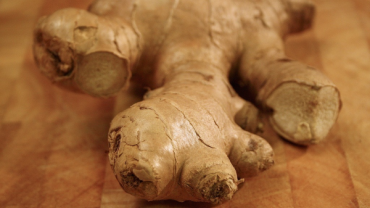
"
The root of the ginger plant Zingiber officinale is actually an underground rhizome a type of modified stem and has been used as a medicinal herb most notably in Chinese and Indian healing traditions since ancient times. In China for example ginger has been used to help digestion and treat stomach upset diarrhea and nausea for more than 2000 years. It also has been used to help fight the common cold flu-like symptoms headaches and painful menstrual periods. More recently as ginger is a powerful anti-inflammatory it has also been used to treat the pain associated with sore muscles rheumatoid arthritis and osteoarthritis.
Like its cousin turmeric ginger presents with a varied and multifunctional therapeutic portfolio that is truly impressive. In western herbal practices ginger has been used primarily for the mitigation of nausea due to various causes including motion sickness and secondary to combat the side effects of radiation therapy. And as mentioned previously ginger has been used in various inflammatory joint conditions displaying anti-arthritic properties.
But like many naturally occurring compounds the complexity of active constituents in these plant-based medicinals confer a multitude of therapeutic benefits many of which may not be well known.
Gastric support
Gastroparesis or delayed gastric emptying is associated with various conditions such as IBS and GERD as well as diabetes and Parkinson's disease. Ginger has been shown to increase gastric motility by stimulating gastric contractions thus reducing food transit times.
Cinnamic acid is an active constituent of ginger that displays a different gastrointestinally beneficial property. This compound has been shown to inhibit the proliferation of the bacteria H. pylori. http://www.ncbi.nlm.nih.gov/pmc/articles/PMC3136331/
Diabetes
Speaking of diabetes gingerols the main active components in ginger act as an aldose reductase inhibitor. Aldose reductase is an enzyme that catalyzes the reduction of glucose to sorbitol. Sorbitol can accumulate in many tissues that are insulin insensitive such as the eyes lens and peripheral nerves which can then lead to tissue damage subsequently causing neuropathy and blindness. Ginger can help reduce this damaging process making it an ideal tool for combating the effects of diabetes.
Potential anti-cancer properties
But perhaps gingers greatest contribution to human health lies in its future. Ginger is being explored for its anti-cancer properties both as a preventative and as an active therapeutic agent. As I so often mention the inflammatory process plays a very active role in the pathogenesis of many disease processes including cancer. Pro-inflammatory cytokines including TNF IL 1 IL- 6 and interferon contribute to carcinogenesis by influencing the survival growth mutation proliferation differentiation and movement of tumor cells. Ginger has been shown repeatedly to inhibit cytokine gene expression in various forms of cancer while increasing cancer cell apoptosis.
Another mechanism of action in ginger's activity against cancer is its antioxidative qualities. Ginger was shown to increase the endogenously produced antioxidant superoxide dismutase while also decreasing lipid peroxidation in animal models of liver cancer.
In breast cancer ginger works its magic by down-regulating various other pro-cancerous pathways including Bcl-X and Mcl-1 two protein molecules that help prevent cell death.
Ginger has been shown to be active against lung cancer by overriding a mutation in the Myc oncogene which causes cancer cells to divide uncontrollably. The Myc oncogene has been a prospective target for drug therapies which has proven to be a difficult goal as it lacks efficient binding sites for drug compounds.
Ginger's broad spectrum of therapeutic actions reminds me of the far-reaching beneficial properties of curcumin which has been discussed in a past blog. As these compounds have similar yet distinct mechanisms of action and are also easily available in the diet or in supplement form we should consider increasing the consumption of them in our daily diet as a prophylactic action against chronic disease.
by Michael Fuhrman D.C.